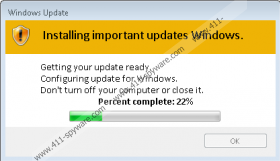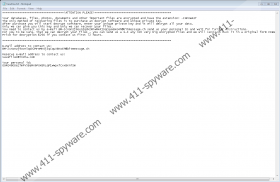INFOWAIT Ransomware Removal Guide
Your inability to secure the Windows operating system could cost you your personal files if INFOWAIT Ransomware got in. This malicious infection is executed using a simple .exe file that might be introduced to you via email as a harmless file attachment (in the .doc, .pdf, .jpg, or another popular format.) or that might be slipped in through existing security cracks without your notice at all. The infection relies on stealthiness and camouflages to fly under the radar, but if reliable security software is installed to protect you and your files, it should be shot down and removed in no time. If you do not have a defense mechanism, the least thing you can and should do is backup your personal files. Depending on the backup method you choose, you can do that for free, and so there is no excuse not to. Backing up files is important because if file-encrypting malware slithers in, your chances of recovering files are slim to none. Note that your files will not be restored when you delete INFOWAIT Ransomware.
After successful infiltration, INFOWAIT Ransomware creates files and Registry entries to mess with the system – the threat can crash Windows Explorer and even disable the Task Manager – and, of course, encrypt files. When files are corrupted, the “.INFOWAIT” extension is added to their names to help you spot them quicker. This extension is one of the few small details that are unique to this malware. Other than that, it is pretty much identical to Guvara Ransomware, Kiratos Ransomware, and other well-known threats from the STOP Ransomware group. Whether one single attacker is responsible for this malware, or multiple parties are exploiting malicious code, all of these infections must be treated in the same way. Of course, that means that they all must be removed. All of these threats create some version of a ransom note file. INFOWAIT Ransomware creates “!readme.txt,” and you will find it created in every folder that contains corrupted files. Needless to say, you should remove this file whenever you find it too.
The text file created by INFOWAIT Ransomware is meant to inform victims that a ransom of $270 can buy them a decryption tool. That is a lot of money, and all of it is likely to be wasted on cyber criminals. Even though they want you to believe that this is the only option you have got to restore your documents, videos, photos, and other kinds of personal files, you do not want to give in; especially if backups exist. In that case, you do not need to worry about the demands made by INFOWAIT Ransomware creators at all. Instead, focus on the removal of the threat and your personal files, which you can replace with backup copies. If such copies do not exist, you might feel stuck. Even if $270 is a sum you can sacrifice, you need to weight the very likely possibility that no decryptor will be given to you in return. On top of that, if you decided to take the risk, you would have to communicate with the attackers (via BM-2cXonzj9ovn5qdX2MrwMK4j3qCquXBKo4h@bitmessage.ch on Bitmessage or savefiles@india.com), and that is extremely risky. Cyber criminals could send you malicious files and scam you again and again.
Where is the launcher of INFOWAIT Ransomware? What is its name? What are the names of other malicious files created by this malicious infection? If you do not have answers to these questions, it is unlikely that you will be able to remove INFOWAIT Ransomware manually. That is okay because you have the option of installing an automated anti-malware program. As long as it is legitimate and up-to-date, it should have no trouble erasing ransomware and other kinds of malware that might exist on your PC. It is even more important that this program can provide you with reliable protection, which is absolutely necessary if you want to avoid malware in the future. Of course, you cannot forget it, and that is why backing up all personal files is important. Do not forget about that once you clean your operating system.
How to delete INFOWAIT Ransomware
- Find the [unique name].exe file that executed the threat and Delete it.
- Delete every single copy of the ransom note file named !readme.txt.
- Launch RUN (tap Win+R keys) and enter regedit into the dialog box.
- In Registry Editor, go to HKEY_CURRENT_USER\Software\Microsoft\Windows\CurrentVersion\Run.
- Delete the value named SysHelper if its value data points to a malicious file in %LOCALAPPDATA%.
- Launch Windows Explorer (tap Win+E keys).
- Type %LOCALAPPDATA% or %USERPROFILE%\Local Settings\Application Data\ into the quick access field.
- Delete the file named script.ps1 and two folders containing [unique name].exe, 2.exe, 4.exe, and updatewin.exe files.
- Once all of these files are erased, Empty Recycle Bin.
- Install a legitimate malware scanner and perform a full system scan.
INFOWAIT Ransomware Screenshots:



